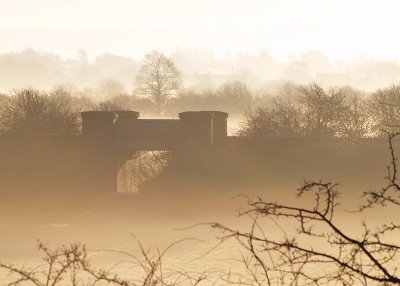So, I reckon that, rain excepted, it is the extremes of weather and any weather that involves sun, that are best for photography. Bright sunlight, sun and cloud, thundery days, snow, frost, and, yes, fog - all are invitations to get out and take photographs. So, what is it about these weather conditions that make them so attractive? Quite simply it's the quality of the light. All of them produce light that a photographer can use to his or her advantage. Some people swear that it's their equipment that allows them to take good photographs. Rarely is it so. Others say that it's the photographer's eye that matters. That's certainly true. And those who have spent a lot of time at photography, and have reflected on their work, know that the capacity to use light is of critical importance.
When I looked out of this Lancashire window on a recent morning I saw the fog turning a fairly mundane scene into something a little more interesting. The disused railway bridge, embankment, trees and bushes were transformed by the fog and rising sun into faint, monochrome shapes, and the unusual light was giving the scene a sepia tone. In taking this photograph I decided to put the bridge to the left and include more of the out-of-focus tops of some nearby trees as a visual counterweight on the right: they also give the picture more depth. This isn't the greatest shot I've ever taken in fog, but I think it does show how light and weather have the power to lift a commonplace scene to a slightly higher level.
photograph & text (c) T. Boughen
